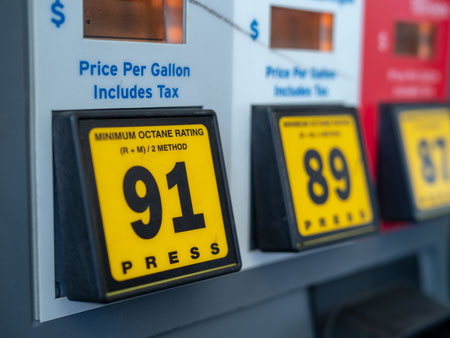Each day, nearly 40 million U.S. drivers refill their vehicle, typically choosing from three to four types of fuel: regular (87 octane), midgrade (89 octane), premium (91 to 93 octane) or E15 (88 octane).
Regular gasoline accounted for nearly 83% of all gasoline sold at U.S. convenience stores, accorinding to the NACS CSX Benchmarking Database, 2024. Premium accounted for almost 9%, followed by midgrade at 6%.
Octane ratings are measures of fuel stability, according to the U.S. Energy Information Administration. In the U.S., gasoline is marketed with an octane value calculated as an average of RON (octane tested under normal driving conditions) and MON (octane tested under more rigorous conditions) and designated on fuel pumps as (R+M)/2. This value, known as the Anti-Knock Index (AKI), is indicates the octane in gasoline that consumers see on fuel dispensers.
 The different grades are related to the types of vehicle engines that require a different level of octane in gasoline. Premium gas can be used in all vehicles that run on gasoline, although it may not deliver better performance if it's not required. Premium is typically required in many luxury and high-performance vehicles. Mid-grade is not required in any vehicles.
The different grades are related to the types of vehicle engines that require a different level of octane in gasoline. Premium gas can be used in all vehicles that run on gasoline, although it may not deliver better performance if it's not required. Premium is typically required in many luxury and high-performance vehicles. Mid-grade is not required in any vehicles.
E15, or 88 octane, is a blend of 15% ethanol (most fuel is 10% ethanol) and 84 octane gas. The added ethanol to the 84 octane fuel lifts the overall octane rating to 88. It is approved for use in all motor vehicles model year 2001 and newer; 90% of all vehicles on the road today can use E15.
If a vehicle is model year 2001 or newer, it can safely use E15. It adheres to the same standards as all other transportation fuels. Its lower price is a function of lower ethanol costs relative to gasoline. However, ethanol does have about one-third less fuel efficiency than pure gasoline, meaning E15 will deliver about 2% less fuel efficiency than E10 fuel. Conversely, ethanol-free gasoline, which is far less common, will deliver about 6% better efficiency.
One note of caution on E15: It should not be used for other vehicles like boats, which is prohibited by federal law, as well as in small equipment like lawnmowers, leaf blowers, etc. Use of E15 could damage the equipment.
Depending on a vehicle's engine design, octane plays a role in engine performance and measures the ability to resist auto-ignition, or knock.
As engine compression increases, so does the amount of power and efficiency generated by a given amount of fuel. The higher the octane, the greater the fuel can withstand compression and resist knock.
An internal combustion engine compresses an air-fuel mixture in its cylinders, thereby raising the mixtures’ temperature and pressure. The air-fuel mixture is ignited with a spark during compression, and the resulting combustion releases heat energy that ultimately powers the vehicle.
Knock can occur at a sufficiently high temperature (a consequence of compression) in the engine cylinders. Long-term, knocking reduces a vehicle’s fuel economy, robs the engine of power and causes engine damage.